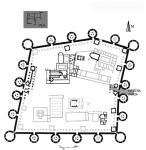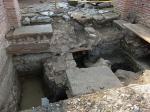Summary (English)
Gamzigrad – Felix Romuliana, 2011.
Eastern Romuliana gate was examined in 1987, 1988 and from 2009 to 2011. All of them were focused on parts of the older fortification, actually on the passage and the southern tower I. It was established that this area was in usage from the end of the 3rd to the end of the 6th century. During 2011, the area in front of the eastern gate, the one between the older and the younger gate and the portico in front of the entrance into tower II of the older fortification were examined (Fig. 1). Foundation zone of the older fortification passage, as well as the drainage system were examined for the purposes of future conservation.
The older building phase of the Eastern gate consists of four massive, rectangular pillars that supported the vault above the portico. Through it, one entered the side towers of the older gate (towers I and II). These pillars’ surfaces were made of regular rows of bricks bound with lime mortar, while their filling represents wall mass made of broken stone pieces bound with lime mortar. Their bases were built of broken stone pieces covered with firm lime mortar with admixtures of sand and small gravel. Between the two pylons of tower II, directly in front of the entrance, there was a large burning layer that contained material from the second half and the end of the 4th century.
The oldest level of this area’s usage is dated to the end of the 3rd century. This is the level situated in front of the tower entrance and it consists of light brown clayish soil with numerous brick fragments originating from the period in which tower II and the portico were erected. To the south of the portico there is a gate passage consisting of larger stone blocks. The blocks were used to close the sewer canal (a collector) made of bricks bound with lime mortar (D-D). A lateral canal of smaller dimensions (B-B) runs into it from the northwest. Above the lower older collector, a younger one was discovered (C-C). The wall that used to split the older collector was positioned under the gate threshold. The bottom of the older collector is positioned exactly 1 m deeper that the bottom of the younger one (Fig. 2). The older collector was made of bricks, while the younger one was made of semi-processed stone. The collector runs outside the fortification, to the east of the younger gate, towards the brook and the Magura hill. Over the collector there was a communication made of stone blocks of irregular shape. It is dated into the second half of the 4th century.Source: Pop-Lazić S., Popović B., Vujadinović V., Gamzigrad – Felix Romuliana. Iskopavanja 2011. godine, Arheologija u Srbiji (Projekti Arheološkog instituta u 2011. godini), Beograd 2012, 74-77.
Fig. 1. Felix Romuliana: ground-plan with position of sites excavated in 2011 (after: Pop-Lazić et al. 2012, 75, Sl. 1).
Fig. 2. Felix Romuliana: Eastern gate of the older fortification, view from the west (after: Pop-Lazić et al. 2012, 76, Sl. 2).
- Milica Tapavički-Ilić - Institute of Archaeology
Director
- Korać Miomir - Institute of Archaeology
Team
- Vujadinović Vujadin - Narodni muzej Čačak
- Pop-Lazić Stefan - Institute of Archaeology
- Popović Bojan - Institute of Archaeology
Research Body
- Institute of Archaeology - Institute of Archaeology
Funding Body
- Ministarstva prosvete, nauke i tehnološkog razvoja Republike Srbije (Ministry of Education, Science and Technological development of the Republic of Serbia) - Ministry of Education, Science and Technological Development of the Republic of Serbia
- Ministarstvo kulutre - Ministry of Culture - Ministarstvo Kulture Republike Srbije - Ministry of Culture of the Republic of Serbia






![Download [PDF]](/excavation/skins/fasti/images/results/download_sml.png)
